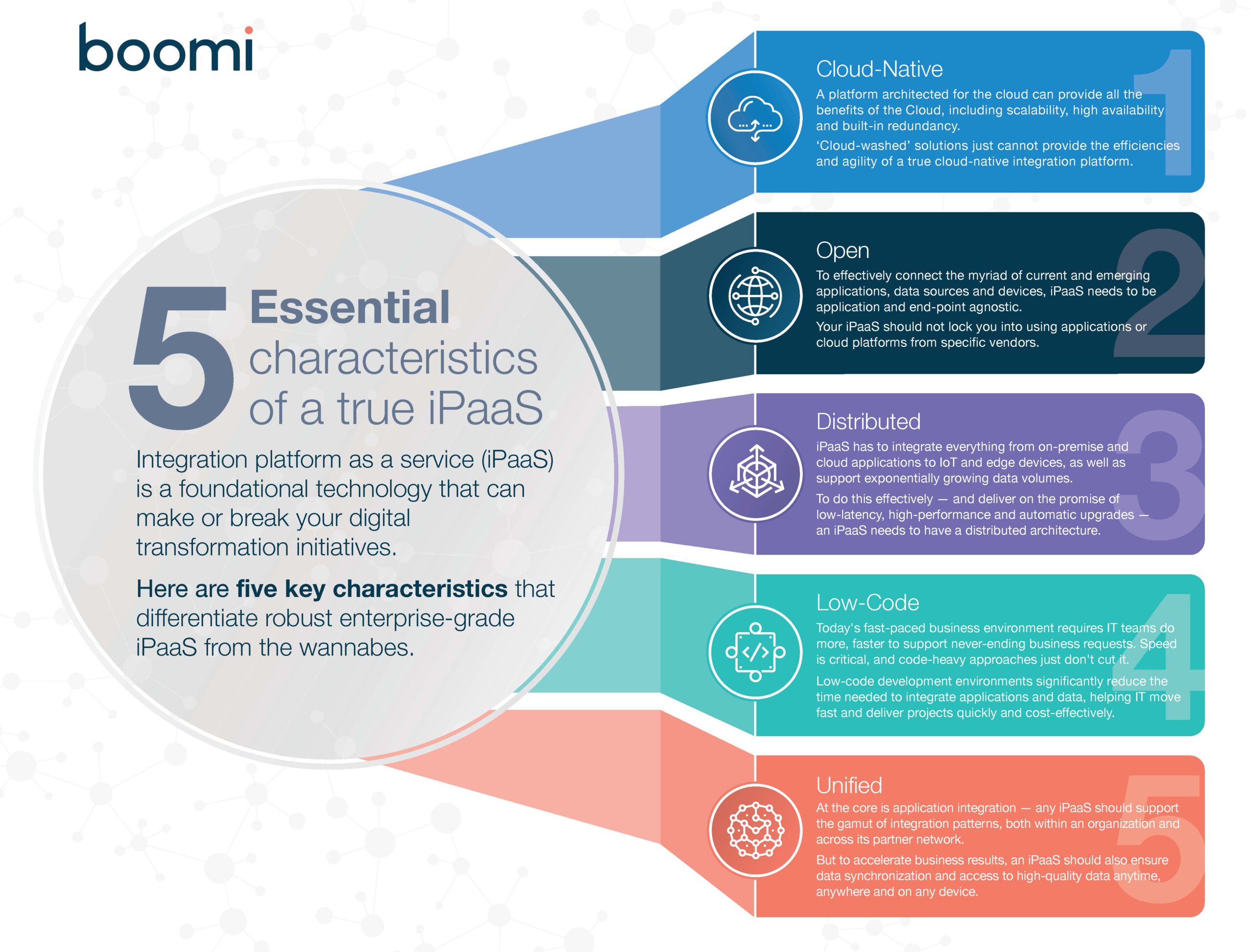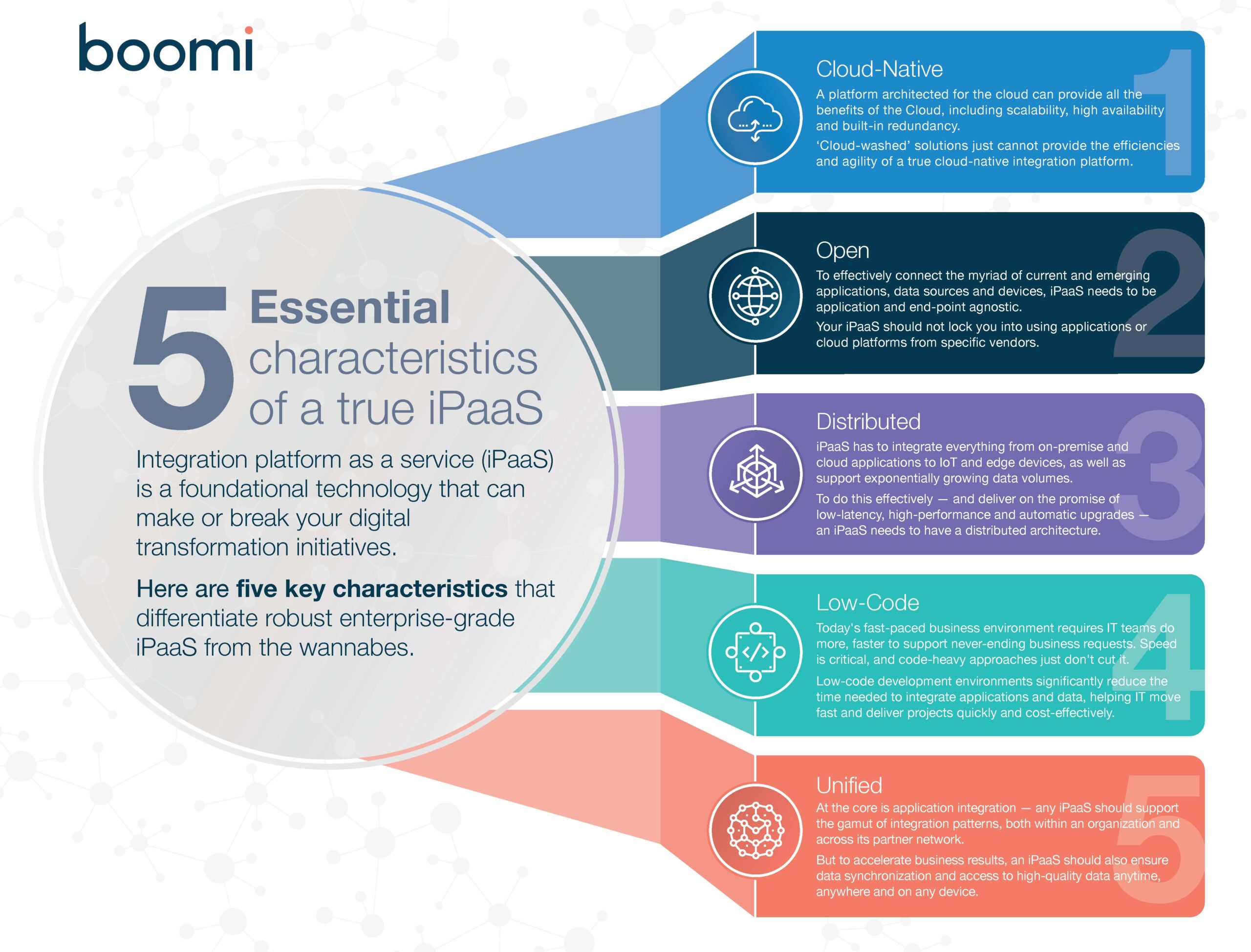For organizations using more than a handful of SaaS solutions, the transfer of data between applications can be time consuming and inefficient. Integrating your suite of SaaS applications so they can share data freely with each other can significantly improve business processes and free up staff time for higher value work.
But not every type of integration provides the same advantages. Proprietary software connectors and custom-built connectors are both ad hoc solutions that may allow data to flow between two applications, but neither solution allows you to create a full ecosystem of applications that share data from every source to every endpoint.
To achieve the best integration results, you should consider a cloud-based solution such as an integration platform as a service (iPaaS). An iPaaS platform is fast, simple, and affordable, while also delivering the highest level of integration.
However, not all integration platforms are the same. Read on to learn more about the five essential characteristics any cloud integration platform should have.
1. Cloud-Native Design
A data integration platform designed to be cloud-native from the ground up provides all the benefits of the cloud, including scalability, high availability, and built-in redundancy. In other words, the advantages an SaaS application has over locally installed software are the same for an integration platform.
Local integrations are cumbersome, expensive, and don’t scale well. Likewise, solutions that consider cloud functionality as an afterthought don’t offer the efficiencies and agility of a true cloud-native integration platform.
2. Open Architecture
To effectively connect the myriad of current and emerging applications, data sources, and devices, your cloud integration platform needs to be application and end-point agnostic. In other words: your integration platform should not lock you into using applications or cloud platforms from specific vendors.
An iPaaS solution offers users a platform to integrate whatever applications they find most useful. And if a connector doesn’t exist for a piece of mission-critical software, the iPaaS provider can build it, or the user can configure the connection themselves. Only with a truly open cloud integration platform can you be free to use the best applications for your specific use case.
3. Distributed Deployment
An iPaaS platform should integrate your entire digital ecosystem across on-premises and multicloud environments, IoT and edge devices, as well as support exponentially growing data volumes. To do this effectively — and deliver on the promise of low-latency, high-performance, automatic upgrades, an iPaaS needs to have a distributed architecture.
Any solution that is deployed locally will be constrained by local limitations. This means that it won’t be scalable at a moment’s notice, which has the added risk of causing systems to crash if demand does spike.
4. Low-Code Environment
Modern IT teams are expected to do more, do it faster, and to support an ever-growing list of business requests. With this increasing workload, the last thing IT needs to do is spend time writing code to build connectors for the latest SaaS applications.
The low-code development environment offered by an iPaaS platform significantly reduces the time and technical expertise needed to integrate applications and data. This helps IT move faster and deliver simple to complex enterprise projects quickly and cost-effectively. In fact, for most use cases, non-technical staff can drag-and-drop prebuilt connectors, bypassing IT entirely.
5. Unified Operations
SaaS application integration is a core need for any digital enterprise. An iPaaS platform should support all your integration patterns, both within your organization and across your broader business network.
To accelerate business results, an iPaaS platform needs to provide users of varying levels of technical skill with the ability to build connections within the same environment. This capability will allow nearly anyone within the organization to assist scaling technical capabilities quickly and easily.
In addition to ease of use, an iPaaS platform must also provide access to trusted data anytime, anywhere, on any device, with centralized management. After all, integrated data is only as useful as it is actionable, and without instant access to the latest data regardless of location, the integration loses its potency.
Accelerate Business with Boomi’s iPaaS Platform
Integration helps organizations bring together all the elements needed for a seamless, friction-free, omnichannel customer experience. This isn’t limited to just technology — an iPaaS platform can connect people and processes as well, supporting the new model for building connected business.
Boomi helps more than 7,000 organizations with their integration needs. Each day, the Boomi platform manages well over a million cloud integrations. Our iPaaS consistently garners industry accolades, ranking at the top of market assessments and competitive comparisons like the Gartner Magic Quadrant for iPaaS year after year.

Want to learn more? Contact us to explore how you can drive digital transformation and become a connected business with a trial of Boomi’s industry-leading integration cloud.







